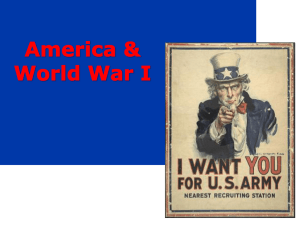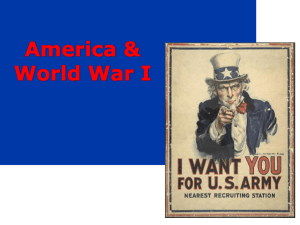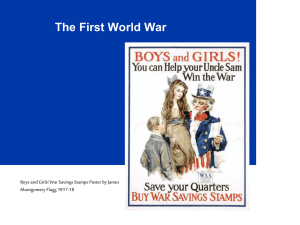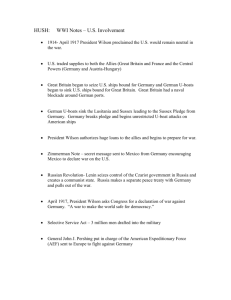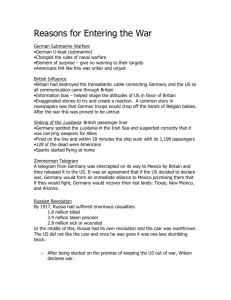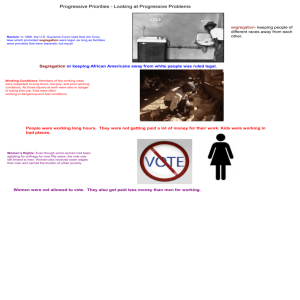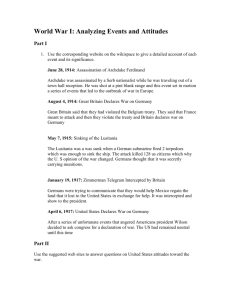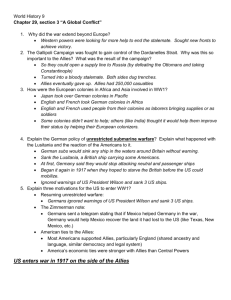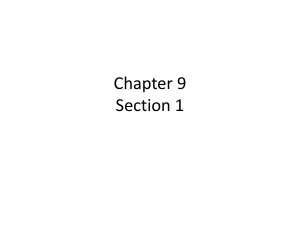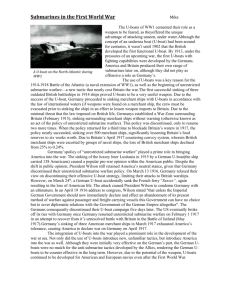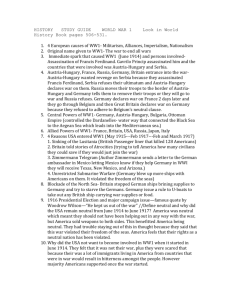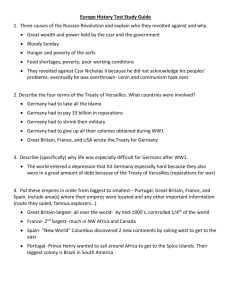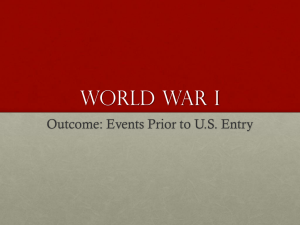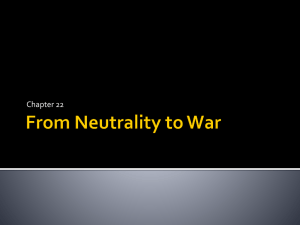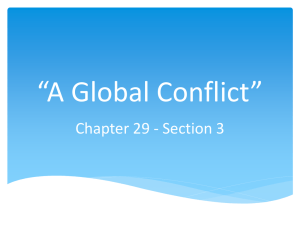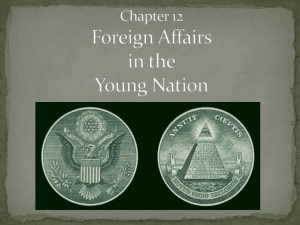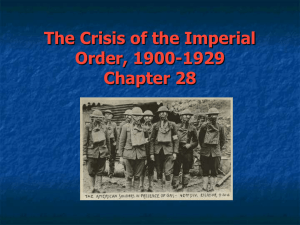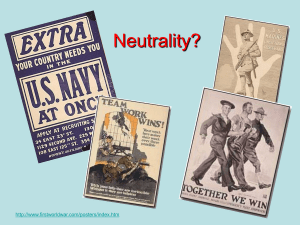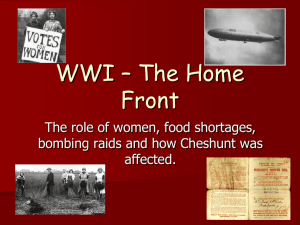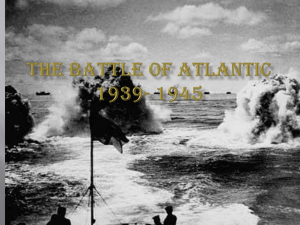Long term
advertisement
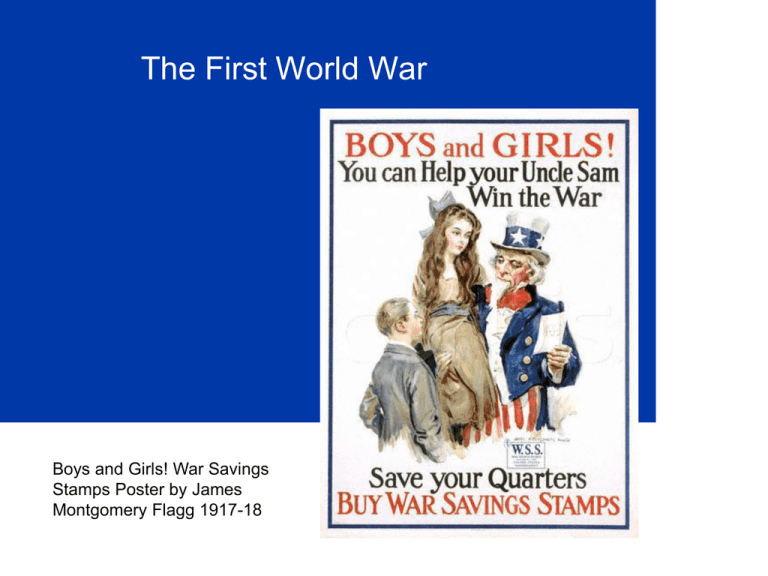
The First World War Boys and Girls! War Savings Stamps Poster by James Montgomery Flagg 1917-18 What do you think this picture represents? ww1 background 2 Guided Study 3 1. Middle East- Apply the acronym M.A.I.N. to the conflict in the Middle East. Iran, Syria, Iraq, Afghanistan, Pakistan, Omen, Yemen, Egypt and Israel with Northern African countries of Libya and Egypt. How does this effect the United States? 2. WW1- Apply the acronym M.A.I.N. to the powder keg that exploded in Europe in 1914. Germany, France, Great Britain, Austria-Hungarian Empire, Russia, Italy, Ottoman Empire, Bulgaria, Serbia. How did this effect the United States? 3. Both groups- How did Military, Alliances, Imperialism and Nationalism lead to conflict? Thinking/Concept Slides Answer the following based from the video: a. What was life like in Europe prior to WW1? b. What two specific areas did Europe's wealth rest on? c. What two continents did Europeans mostly control? d. What is considered a primary cause of WW1? 4 Answers Slide a. Flourishing through new industrial markets and ownership of many lands in Africa and Asia. b. Industrial Strength & Domination over the rest of the world (land and wealth, the building and stockpiling of weapons) c. Africa & Asia d. Imperialist rivalry (Nationalism and imperialism) 5 The First World War: What? •War involving nearly all the nations of the world When? •1914-1918 6 Acronym of WW1 MILITARISM ALLIANCES IMPERIALISM NATIONALISM 7 The First World War: Long term - Why? 1. Alliance system 2. Imperialist Competition 3. Stockpiling of Weapons assassination 8 Franz Ferdinand, Archduke of Austria and his Wife Sophie, Duchess of Hohenberg one hour before their deaths, June 28, 1914 Short term Assassination of Franz Ferdinand of the AustroHungarian Empire The First World War: Who? 9 Central Powers: Allies: Germany Austria-Hungary Ottoman Empire Bulgaria Russia France Great Britain Italy Japan United States (1917) The First World War: Where? 10 Why did it take so long for America to get involved in the war? •America was isolationist •“Why should I get involved in someone else’s problems” 11 Thinking Slide: •Is isolationism really an option for a country as powerful as the United States? 12 Which side should the US pick? Central Powers: Allies: •11 million GermanAmericans •Irish-Americans hated Great Britain •Close cultural ties •Shared transatlantic cables (so censored stories) •Big business loaned much $ to allies US Exports to both sides: 13 Nations Britain France Germany 1914 1915 1916 $594,271,863 $911,794,954 $1,526,685,102 $159,818,924 $364,397,170 $628,851,988 $344,794,276 $28,863,354 $288,899 What did it take to get the US involved? 1. Blockades •Britain blockaded (stopped) all German ships going to America •Germany announced a submarine war around Britain 14 Y-53 German Submarine 1916 What did it take to get the US involved? 1. Blockades •In May, 1915 Germany told Americans to stay off of British ships •They could/would sink them 15 What did it take to get the US involved? 1. Blockades •Lusitania torpedoed, sinking with 1200 passengers and crew (including 128 Americans) 16 German Propaganda Justifying Lusitania sinking •Was eventually found to be carrying 4200 cases of ammunition What did it take to get the US involved? 1. Blockades •The US sharply criticized Germany for their action •Germany agreed not to sink passenger ships without warning in the future 17 Note in Bottle After Lusitania Disaster What did it take to get the US involved? 2. Unlimited Submarine Warfare •1917 Germany announced “unlimited submarine warfare” in the war zone 18 Why? Otherwise their blockade would not be successful What did it take to get the US involved? 3. Zimmerman Note •US intercepted a note from Germany to Mexico, •It promised Texas, New Mexico, and Arizona back in return for an alliance 19 What did it take to get the US involved? •Zimmerman Note + the sinking of 4 unarmed American ships led to a declaration of war 20 Thinking Slide: •Should we tell the story of WWI with Germany as the “bad guy”? Explain. 21 How was the war looking for the allies? Not Good... •Russia left the war after its communist revolution in 1917 •Made it a one front war for Germany - all its troops could concentrate on France 22 Convincing the American People Posters - Gee!! •How do you think this poster helped to convince the American people that the war was a good idea? 23 Convincing the American People Idealism: 2 Goals For War: 1. War to End All Wars 2. Making the World Safe for Democracy 24 Convincing the American People Idealism: Fourteen Points What? President Wilson’s Plan for after the war •Fourteen promises, including freedom of the seas & a League of Nations to work for peace 25 President Woodrow Wilson What did the US do to help? Supplies: •US provided the food, money, and fresh toops needed to win the war 26 American Troops March Through London How did the War Affect the US? Women •Women filled factory jobs •May have led 19th Ammendment after the war (Gave women the right to vote) African Americans •Black soldiers still served in Segregated Units •“Great Migration” - thousands of African Americans moved North to work in factories 27 How did the War Affect the US? Enforcing Loyalty •Hatred of all things German •Ex. “Liberty Cabbage” •Espionage Act 1917 & Sedition Act of 1918 punished those against the war (many labor leaders) 28 29
